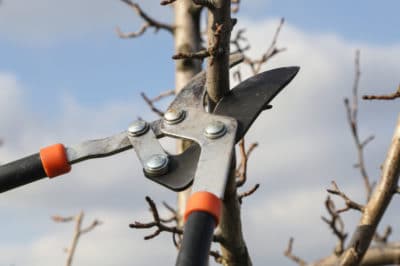When to Prune
As a rule of thumb never prune a tree during the growing season. Pear trees enter a dormant season during the winter. They lose their leaves during this time and go into a state of dormancy. Prune pear trees in late winter when the tree is still dormant before the buds swell.
Keep spring and summer pruning to light trims. Wait until the tree is dormant so it can devote energy to healing the pruning wounds. A tree that is active and growing may go into shock from a heavy prune. Its energy is spent on creating new growth, producing leaves, collected sunlight, nutrients, and producing fruit.
Pruning Wounds
Every time you cut into a tree it is a wound. The tree must then devote energy to healing the wound. In the meantime, it is vulnerable to pests and disease transfer at that location. Fire blight is a common disease that affects pear trees. Pruning is a major factor in the spread of the disease.
Any open wound on a tree is an opportunity for bacteria like fire blight to get inside. Once in the tree’s system, it travels up the braches and to the trunk of the tree causing problems and eventually killing the tree. Here are some ways to prevent disease:
- Sanitize all tool prior to use
- Make clean cuts with sharp pruning shears
- Use protective paint to prevent bacteria from spreading
How To Prune A Pear Tree
Typically pear trees are pruned to a central leader. This means that there is one central branch or trunk that will stay taller than all the lateral branches. The goal is to open the tree up so that air and sunlight can penetrate into the canopy.
Remove branches that criss-cross over each other or are too close together. Clearing out clutter will help air and sunlight enter. Remove branches that are less than a 60-degree angle off of the trunk. Crotches that are under 60 degrees tend to split when the branch gets heavy with fruit. Angles between 60-90 degrees are desirable. Sometimes branches that are close can be staked to the ground so they grow more perpendicular to the trunk.
Remove all of the suckers. Suckers are propagational growth that pop out of the base of the tree and out of the crotches where branches come off the trunk. These will not produce healthy fruit and should be cut out.
